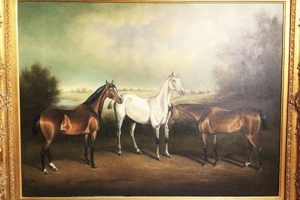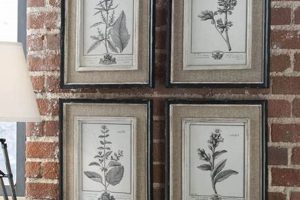Decorative cartography encompassing aged and aesthetically appealing maps finds its application as a visual enhancement for interior spaces. These artifacts, often reproductions or carefully preserved originals, offer a glimpse into geographical perceptions of bygone eras and serve as a focal point within a room’s design. An example includes a framed 17th-century world map displayed above a fireplace, contributing to a room’s overall character.
The incorporation of such items into interior design provides multiple advantages. They impart a sense of history and sophistication, sparking conversation and intellectual curiosity. Furthermore, their inherent aesthetic appeal can complement a range of decor styles, from traditional to modern. Historically, maps were not merely tools for navigation but also works of art, reflecting the skills of cartographers and engravers, rendering them valuable and appreciated decorative items.
The subsequent sections will explore the diverse types of these geographical depictions, examining factors influencing their selection, appropriate display methods, and strategies for ensuring their long-term preservation and care. The goal is to provide a detailed guide for individuals considering the integration of historical cartographical elements into their living spaces.
Considerations for Acquiring and Displaying Decorative Cartography
The following provides advice for selecting and showcasing antique geographical representations to enhance interior spaces. Each point emphasizes thoughtful curation and preservation.
Tip 1: Authenticate the Artifact. Prior to acquisition, ascertain the map’s provenance. Consult with a qualified appraiser or specialist to determine age, origin, and potential restoration history. Accurate assessment affects both financial value and aesthetic presentation.
Tip 2: Assess Print Quality and Condition. Scrutinize the print’s clarity, paper quality, and overall state of preservation. Signs of damage, such as tears, foxing, or water stains, should be evaluated, and potential restoration costs factored into the purchasing decision.
Tip 3: Frame Appropriately. Employ conservation-grade framing techniques to protect the map from environmental damage. Acid-free mats and UV-protective glass are essential to prevent fading and deterioration of the paper over time.
Tip 4: Control Environmental Factors. Implement measures to regulate temperature, humidity, and light exposure in the display area. Direct sunlight and excessive humidity accelerate degradation. Ideally, maintain a stable environment within recommended conservation guidelines.
Tip 5: Choose Location Carefully. Select a location that complements the map’s aesthetic and minimizes the risk of accidental damage. Avoid high-traffic areas or locations prone to spills or physical contact.
Tip 6: Complement the Decor. Ensure the cartography integrates harmoniously with the room’s overall design scheme. Consider the map’s colors, style, and scale in relation to the existing furniture and architectural elements.
Tip 7: Consider Thematic Grouping. If displaying multiple examples, grouping maps by geographical region, historical period, or cartographic style can enhance visual impact and create a more cohesive narrative.
Careful attention to authenticity, preservation, and context ensures that these antique items provide years of aesthetic enjoyment and maintain their inherent historical and cultural value.
The succeeding segment will delve into specific framing techniques and long-term maintenance strategies to safeguard these valuable decorative pieces.
1. Aesthetics
The aesthetic dimension of antique cartography hinges on its capacity to engage visually and evoke emotional responses. The artistic elements inherent in these pieces, such as the ornate calligraphy, detailed illustrations of flora and fauna, and the color palettes reflecting historical pigments, contribute significantly to their decorative appeal. A direct consequence of these visual attributes is the ability of these maps to serve as focal points within a room, dictating style and complementing existing decor. For example, a hand-colored map of the British Isles can introduce a sense of old-world charm to a study or library, influencing the selection of furniture and color schemes.
The importance of aesthetic considerations is further amplified by the diverse range of cartographic styles and periods available. From the classical elegance of Ptolemaic maps to the more utilitarian designs of the 19th century, each style offers unique visual characteristics. A carefully selected map can effectively enhance the perceived value and sophistication of a space. For instance, a minimalist modern apartment can be dramatically enhanced by the inclusion of a large-scale, early world map, its aged parchment tones providing a striking contrast to the clean lines and neutral colors of the room.
In summary, the aesthetic value of antique maps directly impacts their desirability and effectiveness as decorative elements. Understanding the interplay between visual characteristics, historical context, and interior design principles is crucial for selecting and displaying cartography in a way that maximizes its aesthetic potential. The challenges lie in appreciating subtle variations in style and condition, requiring careful evaluation to ensure a cohesive and visually appealing integration into the intended space.
2. Historical Context
The historical context of antique cartography provides essential meaning and depth to its function as decor. Viewing these items as mere aesthetic objects neglects the intricate narratives and intellectual landscapes they embody. Understanding the historical backdrop allows one to appreciate not only the map’s visual appeal but also its significance as a record of evolving geographic knowledge and cultural perceptions.
- The Evolution of Geographical Understanding
Antique maps reflect the historical evolution of geographical knowledge. Early maps, often inaccurate by modern standards, reveal the limited understanding of the world held by past societies. For instance, medieval maps frequently placed Jerusalem at the center of the world, reflecting religious rather than strictly geographical priorities. Displaying such a map alongside later, more accurate depictions highlights the progress of scientific exploration and cartographic techniques. This illustrates how cartography evolved from a blend of observation, speculation, and religious belief to a more empirical science.
- Colonialism and Exploration
Many antique maps are products of colonial expansion and maritime exploration. They document the voyages of discovery, the establishment of trade routes, and the partitioning of territories. Maps from this era often served as instruments of power, delineating spheres of influence and justifying territorial claims. A map depicting the routes of early explorers in the Americas, for example, provides visual insight into the ambitions and impacts of European colonialism. Understanding this historical dimension adds layers of meaning to the decorative piece, prompting reflection on its role in shaping global history.
- Technological Advancement
Cartographic styles and printing techniques have evolved considerably over time, and this evolution is evident in examining items. Early maps, drawn and reproduced by hand, exhibit unique artistic qualities. The advent of printing technologies, such as engraving and lithography, enabled mass production and greater accuracy. Studying the printing techniques used in a particular item provides insight into the technological capabilities of its time. For example, a map printed using intricate copperplate engraving demonstrates the sophistication of printing methods available to 18th-century cartographers.
- Cultural Perspectives and Bias
Antique maps are not objective representations of the world; they reflect the cultural perspectives and biases of their creators and the societies for which they were produced. Maps often prioritize certain regions or cultures, reflecting the prevailing political and economic interests of the time. Depictions of indigenous populations can also reveal biased attitudes or stereotypes. A map created during the height of the British Empire, for instance, may disproportionately emphasize British territories and present a Eurocentric view of the world. Recognizing these biases is crucial for interpreting maps critically and understanding their place within broader historical narratives.
Understanding the historical context behind antique cartography enriches its value as a decorative element. These items are not simply aesthetic objects, but valuable sources of information that provide insight into the past. Integrating a deeper awareness of these contextual factors into the selection and display of antique maps enhances their ability to educate, inspire, and prompt meaningful reflection on history, culture, and geographical knowledge.
3. Print Quality
Print quality is a paramount consideration when assessing vintage cartography intended for decorative purposes. It directly influences the artifact’s aesthetic appeal, legibility, and, critically, its market value. Distinctions in printing methods, paper quality, and ink preservation significantly affect the desirability and longevity of these historical documents.
- Original Printing Technique
The original printing method employed impacts the character and value. Early maps were produced using techniques such as woodcut, engraving, and etching. Each method imparts unique visual characteristics. For example, engraving typically produces finer lines and greater detail compared to woodcut. Identifying the printing technique is essential for authenticating the map and understanding its historical context. High-quality original prints command higher prices and offer greater aesthetic appeal.
- Paper Quality and Condition
The type and condition of the paper significantly affect print quality. Historically, maps were printed on various types of paper, ranging from handmade rag paper to machine-made wood pulp paper. Rag paper is more durable and resistant to deterioration. Signs of damage, such as foxing (brown spots caused by oxidation), tears, or water stains, detract from the overall print quality and value. Assessing the paper’s condition is crucial for determining the map’s suitability for display and potential restoration needs. A map printed on high-quality paper and well-preserved will exhibit greater clarity and longevity.
- Color Application and Preservation
Many vintage maps were hand-colored after printing, adding visual appeal and historical significance. The quality of the color application and its subsequent preservation are vital. Faded or uneven color can diminish aesthetic appeal. Original hand-coloring, if well-preserved, enhances the map’s value and artistic merit. The type of pigments used and their resistance to fading over time contribute significantly to the overall print quality. Maps with vibrant, well-preserved original colors are highly sought after.
- Clarity and Sharpness of Detail
The clarity and sharpness of the printed detail are essential indicators of print quality. High-quality prints exhibit crisp lines, legible text, and well-defined geographical features. Blurring, smudging, or faded details reduce the map’s aesthetic and historical value. The ability to discern fine details, such as coastlines, rivers, and place names, is a hallmark of a well-executed print. Maps with exceptional clarity and sharp detail provide a more immersive and informative visual experience.
In summary, print quality is a multifaceted attribute that significantly influences the appeal and value of vintage maps for decorative purposes. Factors such as the original printing technique, paper quality, color application, and clarity of detail collectively determine the overall aesthetic and historical significance of these items. Careful evaluation of print quality is essential for collectors and enthusiasts seeking to acquire visually compelling and historically valuable cartography.
4. Framing
Framing functions as an indispensable component of preserving and displaying vintage cartography. The selection of appropriate framing techniques directly impacts the item’s longevity, visual appeal, and overall presentation within a space. The inherent fragility of antique paper necessitates protection from environmental factors, including ultraviolet light, humidity fluctuations, and physical handling, all of which accelerate deterioration. Conservation-grade framing employing acid-free mats, UV-filtering glazing, and archival-quality backing boards creates a controlled microenvironment, mitigating these risks. For example, a 17th-century world map, framed without UV protection, will exhibit accelerated fading and paper degradation compared to an identical map framed with appropriate conservation measures. Thus, framing moves beyond mere aesthetics, actively contributing to the document’s preservation.
The stylistic elements of framing influence the visual integration of the cartography within a room’s dcor. Frame materials, color, and design should complement the map’s period, artistic style, and the surrounding interior. A simple, elegant frame in a neutral tone might suit a minimalist space, while a more ornate frame with gilded accents could enhance a traditionally decorated room. The choice of matting, including its color, width, and texture, also affects visual perception. Improperly selected framing can detract from the map’s visual impact, while thoughtful framing enhances its beauty and historical significance. For instance, a reproduction of a medieval map, framed with a dark, heavily textured wood frame, could effectively evoke a sense of antiquity and authenticity, reinforcing its historical narrative.
In summary, framing is not merely a superficial addition but an integral aspect of handling and showcasing vintage map wall art. It serves dual purposes: protecting the delicate artifact from degradation and enhancing its aesthetic integration within a designed space. Challenges arise in balancing conservation requirements with aesthetic preferences. A comprehensive understanding of framing materials, techniques, and their impact on both preservation and visual appeal is essential for collectors and enthusiasts. Proper framing extends the lifespan of these historical documents, enabling them to be appreciated for generations to come.
5. Preservation
The long-term viability of integrating aged cartographical items into interior design rests heavily on the implementation of appropriate preservation strategies. Degradation stemming from environmental factors, improper handling, and inherent material vulnerabilities necessitates a proactive approach to ensure their continued aesthetic and historical value.
- Environmental Control
Maintaining a stable environment is paramount. Fluctuations in temperature and humidity can cause paper to expand and contract, leading to cracking, warping, and eventual disintegration. Direct sunlight exposes items to ultraviolet radiation, causing fading of inks and weakening of paper fibers. Implementing measures such as UV-filtering glazing, climate-controlled storage, and placement away from direct sunlight are critical. A map displayed near a window without UV protection may exhibit significant fading within a relatively short period compared to one displayed under controlled conditions.
- Handling and Storage
Careless handling poses a significant risk of physical damage. Improper folding, creasing, or tearing can irreparably harm the item. When handling, clean, dry hands or cotton gloves should be employed. Storage methods are equally crucial; maps should be stored flat in acid-free folders or sleeves to prevent warping and creasing. Rolling maps for extended periods can cause permanent damage and should be avoided. For example, attempting to unfold a brittle, rolled map without proper support may result in tears and loss of fragments.
- Pest Management
Insects and rodents can inflict substantial damage on paper-based materials. Silverfish, bookworms, and rodents are attracted to cellulose, the primary component of paper. Regular inspection for signs of infestation is essential. Implementing integrated pest management strategies, such as trapping and exclusion, helps minimize the risk of damage without resorting to harmful chemicals. Storing maps in sealed containers can also deter pests. Evidence of past insect activity, such as small holes or frass, necessitates immediate action to prevent further degradation.
- Professional Conservation
When faced with significant damage or deterioration, engaging a professional conservator is advisable. Conservators possess specialized knowledge and skills to repair tears, remove stains, stabilize weakened paper, and reverse the effects of aging. Attempting to repair a damaged map without proper training can exacerbate the problem. A conservator can assess the condition of the item, recommend appropriate treatment options, and execute repairs using archival-quality materials and techniques. Professional conservation ensures the long-term preservation of historical artifacts.
The implementation of these preservation strategies is integral to safeguarding the value and integrity of vintage cartographical items. Attentive care, combined with proactive environmental management, responsible handling, and when necessary, professional conservation interventions, ensures these historical artifacts continue to enrich interior spaces and retain their cultural significance.
6. Authenticity
The concept of authenticity is central to the value and significance of vintage map wall art. It dictates not only the financial worth of a piece but also its historical relevance and aesthetic impact. Determining authenticity involves rigorous assessment of various factors, requiring expertise and careful evaluation.
- Paper and Printing Techniques
The paper type and printing methods used in the map’s creation are indicative of its age and origin. Examining the paper fibers, watermark (if present), and printing technique (e.g., woodcut, engraving, lithography) can help verify authenticity. For example, a map claimed to be from the 17th century but printed on paper made with wood pulp (a 19th-century innovation) would be immediately suspect. Analyzing these material aspects provides crucial evidence for determining the map’s true age and origin.
- Cartographic Style and Content
The cartographic style and geographical information presented on the map must align with the knowledge and conventions of the purported period. Inaccuracies or anachronisms can betray a reproduction or forgery. For instance, a map claiming to depict the Americas in the 16th century but showing the full extent of the Mississippi River, which was not fully explored until later, would raise serious doubts about its authenticity. Verification requires comparing the map’s content with historical records and established cartographic practices.
- Provenance and Documentation
Establishing a clear provenance, or history of ownership, strengthens the claim of authenticity. Documentation such as bills of sale, auction records, or historical inventories can provide evidence of the map’s origin and previous ownership. A map with a well-documented provenance is more likely to be authentic and valuable. Conversely, a map with a dubious or untraceable history may be of questionable origin.
- Expert Appraisal and Certification
Seeking the opinion of a qualified expert or appraiser is often necessary to definitively determine authenticity. Experts possess specialized knowledge and experience in identifying forgeries and reproductions. They can examine the map using specialized tools and techniques, such as ultraviolet light or microscopic analysis, to uncover subtle clues about its age and origin. A certificate of authenticity from a reputable expert provides assurance to potential buyers and collectors.
Authenticity is the bedrock of value for vintage map wall art, influencing its collectibility and historical importance. The above facets are key elements of consideration when determining authenticity of maps.
7. Display Location
The display location exerts a profound influence on both the aesthetic impact and the long-term preservation of decorative cartography. The choice of where to position these historical artifacts within an interior space directly affects their visibility, their integration with the surrounding decor, and their susceptibility to environmental damage. Incorrect placement can diminish the map’s visual appeal, accelerate its degradation, and ultimately reduce its value. Conversely, a thoughtfully selected location can enhance its aesthetic impact, ensure its preservation, and maximize its contribution to the overall ambiance of the room. For example, positioning a delicate 18th-century map in direct sunlight near a frequently opened window will inevitably lead to fading, discoloration, and paper embrittlement, negating the benefits of even the most careful framing techniques.
Considerations for selecting the appropriate display location extend beyond environmental concerns. The scale and style of the map must harmonize with the dimensions and aesthetic characteristics of the surrounding space. A large, ornate world map might overwhelm a small, sparsely decorated room, while a small, understated map could be lost within a grand, elaborately furnished space. The viewing distance and angle are also crucial factors. A map with intricate details should be displayed at a height and distance that allows for comfortable viewing, while a map with bold graphics and simplified details can be effectively displayed from a greater distance. The chosen location should also complement the surrounding decor, reinforcing the desired aesthetic style. For instance, displaying a nautical chart in a study with dark wood paneling and maritime-themed accessories can create a cohesive and immersive atmosphere. Further, high traffic areas are not suitable as the potential of damage is increased.
The selection of an appropriate display location is a crucial element in the successful integration of antique maps into interior design. By carefully considering environmental factors, spatial dynamics, and aesthetic compatibility, it is possible to enhance the visual impact, ensure the preservation, and maximize the historical and cultural significance of these items. Neglecting this aspect can result in diminished aesthetic appeal and accelerated degradation, underscoring the importance of thoughtful planning and careful execution.
Frequently Asked Questions
The subsequent section addresses common inquiries concerning the acquisition, care, and display of geographical representations in interior design.
Question 1: How does one determine the authenticity of decorative cartography?
Authenticity assessment necessitates examination of paper type, printing methods, cartographic style, and available provenance documentation. Expert appraisal is frequently required for definitive verification.
Question 2: What are the optimal environmental conditions for preserving decorative cartography?
Stable temperature (ideally between 65-70F), low humidity (40-50%), and minimal exposure to direct sunlight or UV radiation are crucial. Conservation framing with UV-filtering glass is highly recommended.
Question 3: What are the primary risks to decorative cartography’s physical integrity?
Physical damage, such as tearing, creasing, and abrasion, coupled with environmental factors like humidity, temperature fluctuations, and pest infestations, present the most significant risks.
Question 4: Can damaged decorative cartography be restored?
Yes, professional conservation services can address tears, stains, and other forms of degradation. However, the feasibility and cost-effectiveness of restoration depend on the extent and nature of the damage.
Question 5: How should decorative cartography be handled to prevent damage?
Handle artifacts with clean, dry hands or while wearing cotton gloves. Support during movement and avoid folding, creasing, or applying pressure to fragile areas.
Question 6: What framing techniques provide the best protection for decorative cartography?
Conservation framing employing acid-free mats, UV-filtering glazing, and archival-quality backing boards creates a sealed microenvironment that minimizes environmental risks.
In summary, appropriate care and handling extend the lifespan and safeguard the inherent value of these items.
The concluding segment consolidates key considerations for collectors and enthusiasts.
Conclusion
The preceding analysis has underscored the multifaceted nature of vintage map wall art as a decorative and historically significant element in interior design. Authentication, proper preservation methods, and careful display considerations each contribute to both the aesthetic enhancement of the space and the safeguarding of the artifact for future appreciation. The integration of such items transcends mere decoration, offering a visual and intellectual engagement with cartographic history.
The judicious acquisition and management of vintage map wall art require a commitment to informed decision-making. By adhering to the principles outlined above, collectors and enthusiasts can ensure that these historical artifacts continue to enrich their environments and retain their inherent cultural value. The enduring appeal of these items lies in their capacity to connect individuals with the past, prompting reflection on geographical exploration, cultural exchange, and the evolution of human knowledge.







